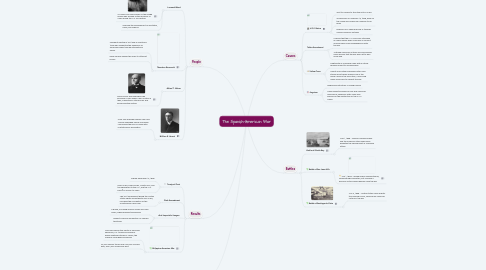
1. People
1.1. Leonard Wood
1.1.1. A colonel and commander of the Rough Riders who worked as the governer of Cuba during the U.S. occupation
1.1.2. Oversaw the improvement of sanitation, roads, and schools
1.2. Theodore Roosevelt
1.2.1. President elected in 1901 and re-elected in 1905 who supported the expansion of American power through international affairs
1.2.2. Gave General Dewey the order to attack at Manila
1.3. Alfred T. Mahan
1.3.1. Naval officer who published The Influence of Sea Power Upon History in 1890, supporting a strong Navy and influencing the military
1.4. William R. Hearst
1.4.1. New York publisher whose New York Journal published yellow journalism concerning the evils of Spain with illustrations by Remington
2. Results
2.1. Treaty of Paris
2.1.1. Signed December 10, 1898
2.1.2. Frees Cuba, cedes Guam, Puerto Rico, and the Philippines to the U.S., and the U.S. pays $20 million to Spain
2.2. Platt Amendment
2.2.1. The 1901 amendment giving the United States rights and authority over Cuba, including the occupation of the Guantanamo naval base
2.3. Anti-Imperialist League
2.3.1. A group, including William James and Mark Twain, arguing against imperialism
2.3.2. Against American annexation of Spanish territories
2.4. Philippine-American War
2.4.1. Two days before the Treaty of Paris was approved, U.S. troops and Filipinos began fighting outside of Manila, the Filipinos using guerrilla warfare
2.4.2. 20,000 Filipino troops and 200,000 civilians died, and 4,300 Americans died
3. Gains in Pacific
3.1. America annexes Hawaii in 1898
3.2. Canal built to cut through Isthmus of Panama, cutting distance from the east to California
4. Causes
4.1. U.S.S. Maine
4.1.1. Sent to Havana to stop the riots in Cuba
4.1.2. An explosion on February 15, 1898, blew up the Maine and caused 254 seamen to be killed
4.1.3. Evidence of a Spanish bomb or torpedo caused American outrage
4.2. Teller Amendment
4.2.1. Claimed that the U.S. could only intervene in Cuban affairs when Cuba was in conflict and promised Cuba independence after the war
4.2.2. Justified America's actions and and relieved some worries that the war was just to gain more land
4.3. Yellow Press
4.3.1. Illegitimate or unreliable news with a catchy headline meant to increase sales
4.3.2. Hearst and Pulitzer published often false stories about harsh Spanish rule or the noble cause of the revolution, convincing many Americans to support the war
4.4. Jingoism
4.4.1. Aggressive patriotism or foreign policy
4.4.2. Many jingoists pushed for war and American dominance, especially after Spain was blamed for the destruction of the U.S.S. Maine
5. Battles
5.1. Battle of Manila Bay
5.1.1. May 1, 1898 - General George Dewey and the American steel ships easily defeated the Spanish fleet in a surprise attack
5.2. Battle of San Juan Hills
5.2.1. July 1, 1898 - Rough Riders charged the hill, suffering high casualties, but claiming a decisive victory which helped close the war
5.3. Battle of Santiago de Cuba
5.3.1. July 3, 1898 - United States Navy defeats the Spanish forces, securing an American victory in the war

